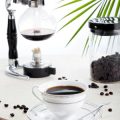Introduction to DIY Coffee Syrups
There’s something truly satisfying about crafting your own coffee drinks at home—especially when you can customize them just the way you like. One of the easiest and most delicious ways to upgrade your homemade lattes and cappuccinos is by making your own coffee syrups. These DIY syrups are simple to prepare, cost-effective, and open up a world of flavor possibilities that go far beyond what you’ll find on grocery store shelves.
Why Make Your Own Coffee Syrups?
Homemade coffee syrups allow you to control the ingredients, adjust sweetness levels, and experiment with unique flavors that suit your personal taste. Unlike many store-bought options, DIY versions don’t rely on artificial flavors or preservatives. Plus, they’re a fun and creative way to bring a café-style experience into your kitchen.
Benefits of DIY Coffee Syrups
| Benefit | Description |
|---|---|
| Healthier Ingredients | You can avoid artificial sweeteners, preservatives, and colorings often found in commercial syrups. |
| Customizable Flavors | Create unique blends tailored to your preferences—like vanilla lavender or cinnamon maple. |
| Cost-Effective | A few pantry staples can yield multiple servings for a fraction of the cost of branded syrups. |
| Sustainable | You reduce packaging waste by reusing bottles or jars to store your homemade syrups. |
The Difference Between Homemade and Store-Bought Syrups
If you’ve ever picked up a bottle of flavored syrup from a supermarket or coffee shop, you might notice a long list of unpronounceable ingredients. Many commercial products prioritize shelf life over quality. With DIY syrups, youre focusing on flavor and freshness—not additives. Heres a quick comparison:
| DIY Syrups | Store-Bought Syrups | |
|---|---|---|
| Main Ingredients | Sugar, water, natural flavorings (e.g., spices, herbs, extracts) | Sugar or corn syrup, artificial flavors, preservatives |
| Shelf Life | Around 2–4 weeks refrigerated | 6 months to over a year unrefrigerated |
| Taste & Freshness | Bolder, fresher flavor with natural notes | Sweeter with synthetic aftertaste |
| Sustainability | No packaging waste if using reusable containers | Adds more single-use plastic or glass waste |
A Better Coffee Experience at Home
You don’t need fancy equipment or barista skills to enjoy an amazing cup of coffee at home. By adding personalized flavors through homemade syrups—whether it’s a rich caramel swirl or a touch of spicy chai—you can turn your daily brew into something special. With just a little prep time, your morning latte becomes more than just caffeine—it becomes a moment worth savoring.
Your Morning Routine Just Got an Upgrade
If youve ever felt like your homemade latte was missing that “coffee shop magic,” DIY syrups might be the secret ingredient you’ve been looking for. In the next section, we’ll cover everything you need to get started—including basic recipes and tools youll need in your kitchen.
2. Essential Tools and Ingredients
If you’re ready to start making your own coffee syrups at home, the good news is—you don’t need a professional kitchen setup or fancy gadgets. Most of the tools and ingredients can be found right in your pantry or with a quick trip to your local grocery store. Here’s what you’ll need to get started.
Basic Tools for DIY Coffee Syrups
These are the go-to items that will make the syrup-making process easy and mess-free:
| Tool | Why You Need It |
|---|---|
| Saucepan | For heating and mixing your ingredients together |
| Whisk or Spoon | To stir and dissolve sugar evenly into liquids |
| Fine Mesh Strainer | Helps remove solid bits like spices, zest, or herbs from your syrup |
| Glass Jars or Bottles | For storing finished syrups—look for airtight containers to keep them fresh longer |
| Funnel (optional) | Makes transferring hot syrup into bottles less messy |
Pantry Staples Youll Use Often
Your homemade syrups will come together with just a few common ingredients. Here are the basics:
| Ingredient | Description |
|---|---|
| Granulated Sugar | The base sweetener for most syrups—dissolves easily in hot water |
| Brown Sugar | Adds a rich, caramel-like flavor—great for fall-inspired drinks |
| Water | You’ll use equal parts water and sugar as the foundation of every syrup recipe |
| Vanilla Extract | A must-have for classic vanilla syrup—go for pure extract if possible for better flavor |
| Cocoa Powder or Chocolate Chips | Create mocha-inspired syrups with these chocolatey additions |
| Cinnamon Sticks, Nutmeg, Cloves, etc. | Add warm spice notes—perfect for seasonal lattes like pumpkin spice or chai-style drinks |
| Lemon Zest, Orange Peel, Fresh Herbs (like mint or rosemary) | Add brightness and complexity to more unique syrup blends |
| Salt (just a pinch!) | Enhances sweetness and balances flavors in your syrup recipes |
Natural Sweeteners & Alternatives to Sugar
If youre looking to reduce refined sugar or try something new, there are several natural options that also bring unique flavors:
| Sweetener | Taste Profile / Notes |
|---|---|
| Honey (raw or local) | Smooth sweetness with floral notes; works well in teas and herbal-infused coffee drinks too. |
| Maple Syrup (pure) | A rich, earthy flavor that pairs beautifully with espresso and oat milk. |
| Coconut Sugar / Agave Syrup / Date Syrup | Slightly different textures but great for experimenting with alternative sweet profiles. |
| Stevia / Monk Fruit Sweetener (for low-carb diets) | Naturally derived zero-calorie options—just use sparingly since they’re much sweeter than sugar. |
Pro Tip:
If youre making multiple syrups at once, label each bottle clearly with the name and date you made it. Most homemade syrups stay fresh in the fridge for about 2–3 weeks when stored properly.
Coming Up Next:
You’ve got your tools and ingredients ready—next up, we’ll dive into easy recipes so you can start crafting flavored syrups right away!

3. Classic Flavors Made Easy
When it comes to making your own coffee syrups at home, starting with the classics is a great way to enhance your lattes and cappuccinos without needing fancy equipment or hard-to-find ingredients. Vanilla, caramel, and hazelnut are three of the most popular flavors in American coffee culture—and they’re surprisingly simple to make.
Vanilla Syrup
Ingredients:
- 1 cup granulated sugar
- 1 cup water
- 1 tablespoon pure vanilla extract
Instructions:
- Combine sugar and water in a small saucepan over medium heat.
- Stir until the sugar is completely dissolved.
- Remove from heat and stir in vanilla extract.
- Let cool and store in an airtight bottle or jar in the fridge for up to 2 weeks.
Caramel Syrup
Ingredients:
- 1 cup brown sugar (light or dark)
- 1 cup water
- 1 teaspoon vanilla extract (optional)
- A pinch of salt (optional, enhances flavor)
Instructions:
- Add brown sugar and water to a saucepan over medium-high heat.
- Stir constantly until it starts to boil, then reduce to a simmer for 5–7 minutes until thickened slightly.
- Add vanilla extract and salt if using, stir well.
- Cool before storing in a sealed container in the refrigerator for up to 2 weeks.
Hazelnut Syrup
Ingredients:
- 1 cup granulated sugar
- 1 cup water
- 2 teaspoons hazelnut extract
Instructions:
- Dissolve sugar and water together over medium heat.
- Once fully dissolved, remove from heat and add hazelnut extract.
- Let cool before transferring to a bottle or jar; refrigerate for freshness.
Syrup Flavor Comparison Table
| Syrup Flavor | Main Sweetener | Main Flavoring | Taste Profile |
|---|---|---|---|
| Vanilla | Granulated Sugar | Vanilla Extract | Smooth, floral, sweet |
| Caramel | Brown Sugar | (Optional) Vanilla Extract + Salt | Rich, buttery, slightly salty-sweet |
| Hazelnut | Granulated Sugar | Hazelnut Extract | Nutty, warm, slightly sweet |
You can mix these syrups into your coffee drinks by adding about one to two tablespoons per cup—or more if you love bold flavor. These homemade versions are not only budget-friendly but also customizable depending on your taste preferences. Try experimenting with different sweeteners like honey or maple syrup for a twist on these classics!
4. Creative and Seasonal Flavor Ideas
One of the best things about making your own coffee syrups at home is the freedom to get creative with flavors that match your mood, personality, or even the season. Whether youre sipping a hot cappuccino on a crisp fall morning or enjoying an iced latte in spring, theres always a flavor combo to make it special. Here are some fun and seasonal ideas to try out:
Unique Flavor Combinations
These DIY syrup ideas go beyond the basics and bring a little flair to your homemade drinks.
| Flavor Name | Main Ingredients | Perfect For |
|---|---|---|
| Lavender Honey | Dried lavender buds, honey, water | Springtime lattes and relaxing weekend sips |
| Pumpkin Spice | Cinnamon, nutmeg, clove, ginger, pumpkin purée, sugar | Fall mornings and cozy afternoons |
| Peppermint Mocha | Cocoa powder, sugar, peppermint extract, vanilla | Holiday treats and winter warm-ups |
| Brown Sugar Cinnamon | Brown sugar, cinnamon sticks, water | Everyday comfort drinks and spiced lattes |
| Vanilla Maple | Pure maple syrup, vanilla extract, water | A warm twist for chilly mornings or brunch drinks |
Tips for Creating Your Own Blends
- Start simple: Use ingredients you already have in your pantry like cinnamon, vanilla extract, or citrus zest.
- Balance sweetness: Adjust sugar levels depending on how sweet you want your drink — remember, less is more at first.
- Think seasonal: Use fruits or spices that are in season for the freshest taste and aroma.
- Add texture: Try infusing syrups with herbs like rosemary or basil for an earthy depth that pairs well with espresso.
How to Store Your Homemade Syrups
Most homemade syrups can be stored in airtight glass containers in the refrigerator for up to two weeks. Label them with the date made and flavor name so you can keep track easily.
Pro Tip:
If youre prepping for guests or planning a coffee bar setup at home, make a few different syrups ahead of time and set them out in small bottles with pumps — its a fun way to let everyone customize their own drink!
The sky’s the limit when it comes to crafting personalized coffee experiences from your kitchen. With just a few ingredients and some creativity, your lattes and cappuccinos will rival any café creation — all while adding that extra touch of seasonal magic.
5. Storage Tips and Customization
Making your own coffee syrups is a fun way to personalize your drinks, but proper storage is key to keeping those flavors fresh and safe to enjoy. Plus, with a few simple tweaks, you can easily adapt recipes to fit different dietary needs like sugar-free or vegan lifestyles.
How to Store Homemade Coffee Syrups
To make sure your homemade syrups last as long as possible, follow these easy storage tips:
Best Practices for Storing Syrups
| Storage Method | Details |
|---|---|
| Airtight Glass Bottles | Use clean, sterilized glass bottles or jars with tight-fitting lids to prevent contamination. |
| Refrigeration | Keep syrups in the fridge to maintain freshness; most last 2-4 weeks when chilled. |
| Labeling | Write the date you made the syrup on the bottle so you know when its time to toss or refresh it. |
Signs Your Syrup Has Gone Bad
- Strange smell or sour odor
- Mold or cloudiness in the bottle
- Taste has changed noticeably
If you notice any of these signs, its time to make a new batch!
Customizing Syrups for Dietary Preferences
You don’t need to miss out on flavor if youre avoiding sugar or animal products. Here’s how to tweak your syrup recipes:
Sugar-Free Options
- Swap regular sugar with natural sweeteners like stevia, monk fruit, or erythritol.
- Dissolve powdered sweeteners in hot water just like sugar. Some may require less quantity due to higher sweetness levels.
Vegan-Friendly Substitutes
- Use plant-based ingredients only—no honey or dairy-based additions.
- Coconut sugar or agave syrup are great vegan alternatives with rich flavor profiles.
Example: Vegan Vanilla Syrup Recipe
- 1 cup water
- 1 cup coconut sugar or agave syrup
- 1 tablespoon pure vanilla extract (make sure its alcohol-based and vegan)
Bring the water and sweetener to a simmer until fully dissolved. Remove from heat, add vanilla extract, let cool, and store in a sealed glass jar in the fridge.


